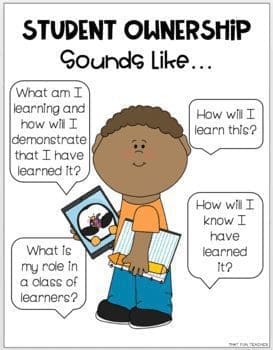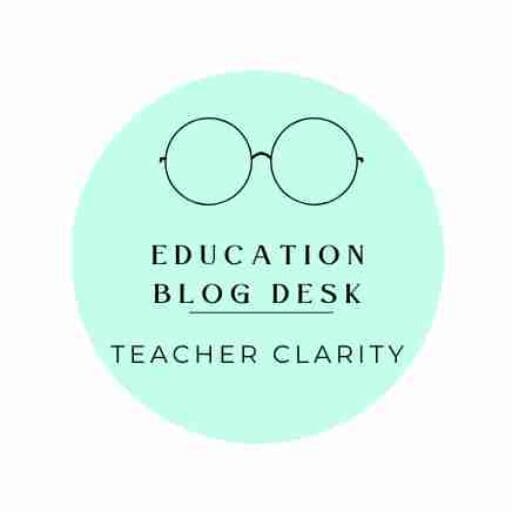
Introduction
The difference between the “look” and “sound” of ownership in learning lies in the outward manifestations of student engagement and responsibility. The “look” of ownership refers to the observable actions and behaviors, such as proactive participation, evaluation of own work, and demonstrating learning in various ways. The “sound” of ownership, on the other hand, relates to the verbal articulation of understanding, the ability to explain learning strategies, and the capacity to connect learning to future applications.
We will be discussing the essence of the differences between the look and sound of ownership in learning and give example of each.
Look of Ownership
The “look” of ownership in learning refers to observable behaviors and attitudes. Observable Behaviors: Students showing ownership might actively participate in class discussions, ask insightful questions, seek out additional learning opportunities, and demonstrate a willingness to take initiative in their work. Attitudes: Students with a strong sense of ownership often exhibit a positive attitude towards learning, a genuine interest in the subject matter, and a belief in their abilities to learn.
What Does it Look like in the classrooms?
So, the look of ownership involves students who are actively engaged, motivated, and selfdirected in their learning process, taking responsibility for their progress and making choices that impact their understanding. This often manifests as initiative, goal setting, and a proactive approach to learning. A learner who demonstrates a proactive approach is able to articulate the purpose of learning, strategies, and how to apply his or her knowledge. This learner is actively involved in their education, not just passively receiving information.
Imagine this happens in your classroom.

Robert Crowe and Jane Kennedy, authors of Developing Student Ownership, use the above slide and slides that you see below to present at California Association for the Gifted 58th Annual Conference — February 22, 2020. Crowe and Kennedy ask educators to think about students in their classrooms, and every student does the following:
● State what they are learning and why.
● Explain how they learn.
● Say when learning and struggling.
● Willing to take risks in learning.
These are connected to the Framework for Learning, as shown below:

Crowe and Kennedy emphasized that students need to move beyond doing and understanding. You can see the following slide.

Do: a student state what task is or recites what he or she is doing literally?
Understand: A student understands what he or she is learning when the student can state what they are learning and make connections.
Own: A student owns his or her learning when he or she can clearly state not only what they are learning but also how he or she is learning.
How can teachers support students so they can own how they are learning? This is when a teaching framework emerges. See below:

Each teacher must answer the following questions:
What am I teaching?
The role of the curriculum is as follows:

When students are supported in developing ownership of learning, all learning should be driven by standards that are:
● Measurable and achievable outcomes
● Integrated approach and conceptual redundancy
● Curriculum materials that match rigor and standards
How will I teach it?

The main aspect of instruction is the opportunity for meaningful engagement using
● Structure student to student communication
● Effective instructional strategies
● Efficient us so instructional time
How will I know it be taught?

In the assessment, all students’ learning are driven by data to:
● Monitor student understanding and feedback
● Monitor current understanding and adjust as needed
● Differentiate based on pre-determined student needs
What is the role played by my students in teaching?

The climate is about when all students’ learning is driven by
● Respectful academic environment
● Cooperative academic environment
● Collaborative academic environment
To learn more, you can download my first e-book Strategic Learning Practices: A Teacher’s Guide to Curriculum, Instruction, and Assessment. Your comprehensive implementation guide for creating a student-centered classroom. This research-backed resource includes the following resources:
● Step-by-step implementation strategies
● Assessment frameworks for student-led learning
● Curriculum planning templates
● Practical tools for immediate classroom use
Download Your Free Teacher’s Guide Strategic Learning Practices: A Teacher’s Guide to Curriculum, Instruction, and Assessment.
Keep in mind “True success in education requires that students to go beyond just doing or understanding school – they must own their learning.” (Crowe and Kennedy, pg.6)
So far, we know the “look” of ownership in learning is about visible actions and behaviors, while the “sound” of ownership is about the learner’s internal voice and self-talk. Let’s dive deeper into Sound of Ownership.
The Sound of Ownership
The “sound” of ownership of learning is characterized by active student engagement, intrinsic motivation, and a sense of responsibility for one’s learning journey. It is a dynamic process which are students take the initiative, set goals, make choices, and reflect on their progress. This empowers them to become self-directed, autonomous learners, fostering a deeper understanding and greater connection to material.
To show what “sound” of ownership looks and sounds like Putting Students in Charge of Their Learning will show how it is done.
Putting Students in Charge of Their Learning
Beth Pandolpho, author of Putting Students in Charge of Their Learning, used two main questions to guide her decision-making in writing lesson plans:
What do I want students to know and be able to do as a result of this lesson?
How can I design an activity in which students can search for answers?
Pandolpho’s goal was to design activities that foster learner independence. She feels that this is essential because they invite students to engage more thoughtfully with the content, and that engagement should include students talking about their work.
Pandolpho introduced a complex idea or problem and then turned it over to her students for further inquiry. She explained that these lessons generally consist of concepts that challenge students’ thinking, call into question their preconceived notions, invite controversy, and have multiple pathways. While students are busy searching for answers, Pandolpho joins conversations, asks probing questions, and provides guidance and feedback as they draw their conclusions. Pandolpho believes that empowering students to be in charge of their own learning is to create interesting, open-ended tasks that target real-world skills, meet our learning objectives, and enable them to make choices and then measure and reflect on their progress.
Making Choices
Pandolpho challenges her ninth graders to write editorials about issues they felt passionate about and quickly began to share their opinions about a range of issues, such as gun safety, discrimination on gay dating sites, increased wages for the military, and how veganism may be a solution to global warming.
She teaches strategies for effective argument writing, and her students eagerly began to search for sources to prove their points, attempting to convey the magnitude of the issues yet temper their obvious bias, so that they could convince readers to change their thinking.
Pandolpho explains if you listened in on our editorial conferences, you would have heard students asking, “Do you know where I can find?” or, “Does this sound too harsh?” or the more difficult question, “How do I acknowledge the opposing position if I really don’t understand their side?”
These are the conversations she wants to have in her classroom because these are students who are in charge of their own learning.
She cites Hanover Research “Student choice makes students active participants in their education, thereby increasing their levels of engagement. Notably, researchers highlight the fact that such autonomy is generally associated with greater personal well-being and satisfaction in educational environments as well as in terms of academic performance.”
Measuring Students Progress
Pandolpho uses “rubrics” (like this one) that provide meaningful measures to help them monitor students’ progress during an activity or project; we can circulate and confer as they use the rubric to guide their work and ultimately improve their performance. She believes that the teacher feedback offered during this process should be objective and nonjudgmental, as the rubric dictates the measures for a successful outcome.
Pandolpho explains that teaching students to self-assess their metacognition and independence—valuable skills throughout their lives. Pandolpho believes in using feedback is based on what British professor Dylan Wiliam writes that “The amount of feedback we can give our students is limited. In the longer term, the most productive strategy is to develop our students’ ability to give themselves feedback.”
Engaging in Reflection
Pandolpho routinely gives her students class time to reflect on their own learning. She offers students this analogy: “Learning does not just happen because we get an A, or do not make the final cut for the track team. We learn when we reflect on why we were or were not successful, and how we can make changes going forward to reach a different outcome.” to illustrate the power of reflection.
Pandolpho cites Jay McTighe who offers these questions for self-reflection:
● What aspect of your work did you think was most effective? Why? How so?
● What aspect of your work does you think was the least effective? Why? How so?
● What specific action(s) would improve your performance, based on the feedback received?
● What advice would you offer to the next year’s students to help them perform this task?
● What did you learn from working on this task about the content, topic, process, and/or yourself?
Pandolpho concludes that “When students are in charge of their own learning, they feel a sense of belonging—the classroom becomes a space defined by them. And paradoxically, in providing greater autonomy for students, teachers are more important than ever because only a skilled teacher can set up the scaffolding for this kind of learning experience and thoughtfully guide students through each step of the process.” Pandolpho continued to explain that, similar to adults, students feel valued and respected when an experience challenges them, reflects their interests, and allows their voices to be heard. And when they are the authors of their own stories, they attend to each moment because they care deeply about the rising action, the falling action, and the resolution—the triumphs and the lessons are their own.”
My Take Away
I learned the difference between look and sound when I got the idea to break down of the characteristics of Look and Sound of Ownership of Learning. I reserached the “look” of ownership in learning and it refers to observable behaviors – Students showing ownership might actively participate in class discussions, ask insightful questions, seek out additional learning opportunities, and demonstrate a willingness to take initiative in their work and attitudes -Students with a strong sense of ownership often exhibit a positive attitude towards learning, a genuine interest in the subject matter, and a belief in their abilities to learn. I used Robert Crowe and Jane Kennedy, authors of Developing Student Ownership, presentation at California Association for the Gifted 58th Annual Conference — February 22, 2020 to reflect the characteristics of the look of ownership.
While the “sound” of ownership of learning is characterized by active student engagement, intrinsic motivation, and a sense of responsibility for one’s learning journey. It is a dynamic process which are students take the initiative, set goals, make choices, and reflect on their progress. This empowers them to become self-directed, autonomous learners, fostering a deeper understanding and greater connection to material. Beth Pandolpho, author of Putting in Charge of Their Learning, reflects the characteristics of sound of ownership in that Pandolpho enocurage students to take initiative, and empowers them to become self-directed and autonomous learner by giving them choice and voice, and reflect on their progress.
I hope this comparison between Look and Sound of ownership of learning gives you an idea of how ownership works.
